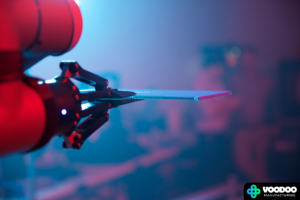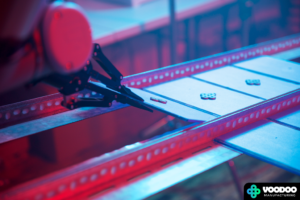 It’s already been a big year for New York’s Voodoo Manufacturing, which has grown to become one of the biggest 3D printing manufacturing facilities in the city in only a little over a year of existence. This fast-growing company, formed by a group of former MakerBot engineers, has been an exciting one to follow, and they hit the ground running in 2017, announcing a facility expansion and $1.4 million in seed funding before January was even over. Today, Voodoo Manufacturing has unveiled a remarkable new invention that shows, once again, that this is a company worth investing in.
It’s already been a big year for New York’s Voodoo Manufacturing, which has grown to become one of the biggest 3D printing manufacturing facilities in the city in only a little over a year of existence. This fast-growing company, formed by a group of former MakerBot engineers, has been an exciting one to follow, and they hit the ground running in 2017, announcing a facility expansion and $1.4 million in seed funding before January was even over. Today, Voodoo Manufacturing has unveiled a remarkable new invention that shows, once again, that this is a company worth investing in.
 The word “innovative” is easy to overuse, particularly in this industry, but there’s no other way to describe what Voodoo Manufacturing has named Project Skywalker: a fully functional, robot-operated 3D printer cluster. It was developed because, according to the company, employees were spending up to 15% of their time “harvesting” build plates, i.e. removing them from the printers after print jobs were completed, taking the prints off the plate, and replacing them on the printers. It’s a task that can be a minor annoyance to individual, at-home 3D printer users, but in a large 3D printing facility churning out thousands of prints every day, it adds up to a lot of time being spent by employees who have plenty of other things they need to do.
The word “innovative” is easy to overuse, particularly in this industry, but there’s no other way to describe what Voodoo Manufacturing has named Project Skywalker: a fully functional, robot-operated 3D printer cluster. It was developed because, according to the company, employees were spending up to 15% of their time “harvesting” build plates, i.e. removing them from the printers after print jobs were completed, taking the prints off the plate, and replacing them on the printers. It’s a task that can be a minor annoyance to individual, at-home 3D printer users, but in a large 3D printing facility churning out thousands of prints every day, it adds up to a lot of time being spent by employees who have plenty of other things they need to do.
The Skywalker system was designed to take over that task so that employees can direct their time elsewhere. It consists of nine 3D printers mounted on server racks, plus a robot arm that removes build plates and places them on a track for employees to collect once print jobs are finished. A plate “hopper” then feeds clean build plates to the robot, which replaces them on the printers for new print jobs to begin. Internal software lets the printers communicate to the robot when print jobs have finished and when new ones need to be started. See it in action below:
https://youtu.be/GoNRTucoErE
According to Jonathan Schwartz, Co-Founder and Chief Product Officer at Voodoo Manufacturing, the company recently left the robot to run unmanned overnight, and returned to find that it had successfully been producing 3D printed parts for 14 hours straight. They now plan to scale it up and increase the factory’s capacity by 400%, with the goal of creating a “lights-out” system that operates completely without human intervention – where the lights can be literally turned off and the factory closed for the night while the machine continues to work.
“We are excited to participate in what we view as a fundamental industry transition that will define the way we make things for the foreseeable future,” Schwartz said. “However, this will most certainly create a new world economy where manual labor becomes automated in the majority of factories. We respect that this is a problem, so we all have a lot to talk about.”
 That’s exactly what 3DPrint.com talked about with Max Friefeld, Voodoo Manufacturing Co-Founder and CEO, when we spoke to him about Project Skywalker’s development. It’s estimated that 1.3 million industrial robots will be placed in factories by 2018, saving manufacturers billions of dollars but causing concern for many employees who worry that robots will put them out of work. Friefeld, however, believes that there is plenty of room for both humans and robots in the factories of the future.
That’s exactly what 3DPrint.com talked about with Max Friefeld, Voodoo Manufacturing Co-Founder and CEO, when we spoke to him about Project Skywalker’s development. It’s estimated that 1.3 million industrial robots will be placed in factories by 2018, saving manufacturers billions of dollars but causing concern for many employees who worry that robots will put them out of work. Friefeld, however, believes that there is plenty of room for both humans and robots in the factories of the future.
“Skywalker will not be replacing any of our employees,” he assured us. “It will enable them to focus on higher-value tasks compared to what we’ll be using robots to automate. Over time, this leverage will enable Voodoo to grow and continue hiring more people to work both within our factory and other departments (i.e. as our business grows we’ll need more customer support, sales, marketing, etc.) We don’t think of automation as a zero-sum game, where a robot gaining tasks means that a person must lose tasks (or their job). This is true because manufacturing demand and output in the United States, the World, and at Voodoo, is growing rather than staying constant or shrinking. This is a trend we expect will continue, mostly thanks to the efficiencies gained by automation.
Speaking about manufacturing in the United States only, the truth is we’re not going to see a return of traditional manufacturing jobs, even though we will see a return of domestic manufacturing spending and output. Manufacturing has left the US over the past decades because overseas factories could provide comparable services for much lower costs, due to lower labor costs. However, all manufacturing companies are now looking towards automation as a way to cut costs, improve quality, and increase output. Within the US, this will be an opportunity for existing manufacturing companies to compete on price once again, and for new manufacturing companies to innovate and create entirely new services that redefine how things are manufactured. As a result, we would expect that we’ll actually see a net increase in manufacturing jobs in the US over the next decade.”
That thought should comfort many, and while Voodoo Manufacturing has no plans to commercialize Project Skywalker, the system may well serve as an inspiration to other manufacturers looking to increase productivity. Friefeld expects Voodoo’s productivity to go up dramatically and quickly, reducing costs by 90% and competing with injection molding production runs of up to 100,000 units. That’s a bold statement indeed, and will likely make a lot of people in the manufacturing industry take notice – particularly those who have written off 3D printing as a method of mass production.
Friefeld went on to tell us more about the development of Project Skywalker.
“Knowing the task we wanted to automate, we choose the Universal Robots UR10 robotic arm as our method for automation,” he said. “The UR10 provided a low-enough price point paired with surprising precision and payload capacity sufficient for the target task. Most attractive, however, was the collaborative nature of the robot. Traditional robotic arms are large, expensive, powerful machines that require intense safety protocols and path planning to use. Collaborative robots, on the other hand, provide an approachable device with the promise of safe human interaction. Rather than build a factory with caged-off areas and hazardous possibilities, we preferred the idea of a friendly workplace where continuous and spontaneous improvement and interaction are default.
With arm in hand, we constructed the rest of the demo system, consisting of 9 3D printers mounted to server racks, a track where the robot could deposit harvested plates eventually be collected by an employee, and a custom-built plate ‘hopper’ that would feed new, clean plates to the robot as needed. Once all components were in place, we were able to collaboratively plan the paths to and from all 9 printers, the plate track, and the plate hopper. Lastly, using our internal software, we were able to establish communication between the printers and robot. We could notify the arm when a print finishes and on which printer, and receive notification of when the arm successfully placed a new plate on a printer, thus signaling the automatic start of a new print. After solving many edge cases and unforeseen problems, we eventually arrived at the finish line and built what we know to be the first-ever robot-operated 3D printer cluster.”
The system is quite something to watch in action, and it’s easy to believe Friefeld and Schwartz’s estimations of the staggering increases in productivity that the invention will allow. You can learn more below:
https://youtu.be/Gv5MI1OG0_k
Discuss in the Project Skywalker forum at 3DPB.com.
Subscribe to Our Email Newsletter
Stay up-to-date on all the latest news from the 3D printing industry and receive information and offers from third party vendors.
Print Services
Upload your 3D Models and get them printed quickly and efficiently.
You May Also Like
3D Printing News Briefs, July 2, 2025: Copper Alloys, Defense Manufacturing, & More
We’re starting off with metals in today’s 3D Printing News Briefs, as Farsoon has unveiled a large-scale AM solution for copper alloys, and Meltio used its wire-laser metal solution to...
3DPOD 260: John Hart on VulcanForms, MIT, Desktop Metal and More
John Hart is a Professor at MIT; he´s also the director of the Laboratory for Manufacturing and Productivity as well as the director of the Center for Advanced Production Technologies....
3D Printing News Briefs, June 28, 2025: Defense Accelerator, Surgical Models, & More
In this weekend’s 3D Printing News Briefs, 3YOURMIND was selected to join an EU Defense Accelerator, and PTC has announced model-based definition (MBD) capabilities within Onshape. Finally, a study out...
EOS in India: AM’s Rising Star
EOS is doubling down on India. With a growing base of aerospace startups, new government policies, and a massive engineering workforce, India is quickly becoming one of the most important...





































